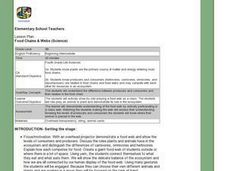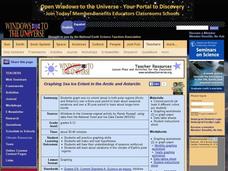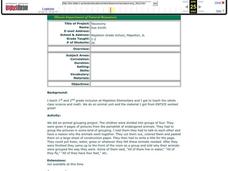Curated OER
Back to the Past
Pupils label fossil imprints. In this Geology lesson, students view fossil imprints of several items. Pupils explain what a fossil is.
Curated OER
Discovering Cells
Students will learn about the pioneers who discovered the cell and its parts. They will be able to relate advances in microscope technology to the discoveries. Students diagram a time line and answer questions at the end to check for...
BBC
Local Democracy
Expanding our students' understanding of government at a local level is a great way to build an understanding of government at a global level. Start the understanding by using any of these fun teaching ideas. Learners engage in several...
Curated OER
How We're Connected
Learners take a survey in order to find out how they live in relationship to the environment. They take the time to investigate the differences between a need and a want. This is done as part of the self-assessment. Students also study...
Curated OER
Introduction to Graphs
Students poll classmates to gather information for a graph. They identify three types of graphs (bar, line, table). Students create each type of graph using data gathered from classmates.
Curated OER
All Aboard the Safety Train
Students listen to a story about safety around trains and participate in story retelling students complete an art project.
Curated OER
Get to Know a Fish
Students discover the anatomy of a fish by identifying its body parts. In this oceanography lesson plan, students view a live fish in their classroom and draw a poster of the fish one body part at a time while identifying it....
Curated OER
Food Chains & Webs
Fourth graders examine roles of animals in food chain, explore roles of humans, plants, and animals in ecosystem, create their own food webs, and role play producers, consumers, and decomposers.
Curated OER
Back To The Drawing Board
Students recognize and imitate Leonardo da Vinci's unique artistic style. Through observation and practice, students capture the look of real things from many angles in actual space. They attempt their own still life drawing.
Curated OER
Dissolved Oxygen in an Aquatic Ecosystem
Students explain why dissolved oxygen is important in aquatic ecosystems. They evaluate the optimal dissolved oxygen levels for living organisms.
Curated OER
Monstrous Mutations
Students investigate mutations and simulate their mutation while trying to collect food. In this mutations lesson plan, students pick an identified mutation out of a paper bag. They simulate their mutation while trying to collect food...
Curated OER
Invertebrate Diversity
Young scholars observe different animals with bilateral symmetry. In this biology instructional activity, students compare how these animals move. They discuss the evolutionary history of observed animals.
Curated OER
Graphing Sea Ice Extent in the Arctic and Antarctic
Students graph sea ice data and predict long term trends in the data. In this climate change lesson, students use sea ice data from the Arctic and Antarctic to construct line graphs. They use their graphs to predict the effects of global...
Curated OER
What do two-dimensional tessellations look like? Where in art can they be found?
Students explore the world of art and culture, including the works of M.C. Escher. They identify and create original tessellations. Students use a wealth of interactive multimedia applications. They explore the artistic representations...
Curated OER
Movie Genres
In this grammar worksheet, students match twelve movie genres with their appropriate definitions and examples from two answer banks and then translate the titles into Chinese. Students answer six questions regarding personal movie...
Curated OER
Where Are the Dinosaurs?
Students explore what the dinosaurs were like. In this dinosaur lesson, the teacher peaks student curiosity about dinosaurs. This lesson would be a great starting point for a dinosaur unit since it primarily engages student interest and...
Curated OER
Owl Pellets
Sixth graders investigate the role of owls in their ecosystem. In this food chain lesson, 6th graders illustrate an owl food chain, dissect an owl pellet, and analyze data. Students discuss what would happen to owls if there were an...
Curated OER
Race the Track! Super Slope (Lesson One)
Fifth graders utilize basic physics concepts to calculate speed of an object set in motion from various heights. In this basic physics lesson, 5th graders make observations, calculations, record data, and conclusions throughout experiment.
Curated OER
Terrestrial Communities
Young scholars watch a video about different terrestrial communities. They conduct an experiment with sponges conserving water. They research desert characteristics comparing them with other biomes.
Curated OER
Aquatic Communities
Students watch a video about aquatic communities. They conduct an experiment that shows how movement of rivers change the landscape. They compare fresh and salt water communities and its wildlife.
Curated OER
Taxonomy
Students work together to identify groups of endangered animals. Using a pamphlet, they group the pictures according to specific criteria and cut the pictures out and color them. They place the animals in the correct habitat and share...
Curated OER
Glow With the Flow
Students investigate the force of drag and how NASA engineers use models and glowing paints to examine how air flows over vehicles in a wind tunnel. They discover how the blended wing body will affect air travelers of the future.
Curated OER
Angle Action
Students measure and label specified angles. In this angles lesson, students use a protractor to find angles that are acute, obtuse, and reflexive. Students then label each angle and match the angles the correct definition. This lesson...
Curated OER
Beaver Ecology
Students explore the lives of bgeahvers. They identify the physical and behavioral adaptations that help beavers survive in their environment. Students compare and contrast how beavers influence the ecology of both forest and aquatic...

























